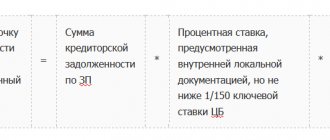Additional wages for a person are accrued in certain cases and to specific categories of citizens. However, it is considered separately from the basic income, which people receive consistently every month. Accountants handle the calculations, so a person does not need to independently determine the amount of money. However, it will be useful to control the calculations, because employees may make mistakes or forget about some important factor. To do this, let’s figure out what an additional salary is and what it includes.
What is salary
Perhaps some people, having read the title of our article, will say that this is an uninteresting topic and accountants, and not ordinary workers, should deal with the calculations. But we do not agree with this, because every person who receives a salary must control the amount of his payments. Accountants sometimes make mistakes, and in this case, you may not receive your hard-earned money.
Sometimes it happens that managers deliberately do not pay the necessary bonuses that are due to employees by law. To prevent this from happening, we recommend that you find out how wages are calculated and what their amount depends on.
Salary is a material reward for work performed. Accrued for hours actually worked.
Basic salary
Salary is the remuneration of an employee for the work he has performed. This concept includes payment for actual time worked, compensation accruals, as well as additional incentive payments in the form of allowances, bonuses, and additional payments.
The base salary is the base amount an employee is guaranteed to receive each month.
The following table illustrates the types of basic salary.
| Remuneration system | What is |
| Monthly salary | In this case, the employee is paid a fixed amount monthly in accordance with the employment agreement |
| Basic salary | Represents the minimum amount of payment for a specific position, used for state and municipal employees |
| Application of tariff schedule | This option involves assessing the working hour; before payment, the working time is summed up and the basic salary is calculated based on this |
Factors influencing wages
In different regions of the country at different enterprises, the salary of employees is not the same.
The following factors influence this:
- Qualifications of employees. For example, the higher the rank of a mechanic, the higher his tariff rate and the higher his salary.
- Special working conditions. In industries where an employee performs harmful and dangerous work, appropriate bonuses are paid, due to which the amount of monthly payments increases.
- Demand for workers of a certain specialty. For example, if we consider the village, the demand for tractor drivers is much higher than the need for IT specialists.
- Fulfillment of qualitative and quantitative indicators by the enterprise. If the company is doing well, then management gives bonuses to employees.
- Personnel policy of the company. At some enterprises there are some kind of production competitions. The shift that completes the most work at the end of the month receives a monetary reward.
Incentive payments
Incentive payments are not established by labor legislation, since the decision on their appointment is made by the management of the organization. However, if such payments are specified in an employment or collective agreement, then they become mandatory.
Incentive payments include:
- bonuses assigned for any reason to those employees who have proven themselves in any way during the performance of their job duties;
- material assistance to employees of the organization, for example, at the birth of children, which is assigned by management and paid from the organization’s budget;
- additional payments for various ideas and their implementation, the development of any projects and other activities that have a positive effect on the enterprise;
- incentives for employees on professional holidays, etc.
Incentive payments also include rewards for active workers at the end of the year; most often such benefits are called the thirteenth salary. Despite this name, this category of funds is an incentive payment.
What is the basic and additional salary?
The basic salary is payment for hours worked or a task completed, and the amount of payments corresponds to established labor standards (for example, tariff rates or salaries).
To learn how to calculate the basic salary, you need to understand what a salary is and what a tariff rate is.
All employees, when hired at a company, sign an employment contract. It is there that it is indicated what form of payment you will receive.
Salary is a fixed amount specified in the staffing table that an employee receives for the monthly number of hours worked.
That is, the amount of the employee’s basic salary with salary will be equal to his salary.
The tariff rate is the cost of an hour of work for an employee.
At the end of the month, calculations are carried out according to the formula:
Tariff rate × Number of hours worked = Basic salary
Additional salary is payment for overtime work, various labor achievements and bonuses for special working conditions.
All salary supplements are prescribed in the Labor Code of the Russian Federation.
They are awarded in a number of cases:
- If an employee works in hazardous work, then he is entitled to a bonus for hazardous work, according to Article 147 of the Labor Code of the Russian Federation in the amount of 4% of the basic salary.
- If job duties have to be performed in special climatic conditions. For example, if the company is located in the North. Payments are made on the basis of Article 148 of the Labor Code of the Russian Federation. And their value depends on the regional coefficients (geographical location of the enterprise).
- According to Article 152 of the Labor Code of the Russian Federation, payment for overtime hours is also considered an allowance. The first 2 hours worked in excess of the monthly norm are paid at one and a half times the rate, and the rest at double.
- If an employee has to go to work on holidays and weekends, then, according to Article 153 of the Labor Code of the Russian Federation, his rate is doubled or paid time off is provided.
- If the employment contract provides for night shifts, then the time from 10 pm to 6 am is paid 20% higher, according to Article 96 of the Labor Code of the Russian Federation.
- If an employee combined several positions or replaced an absent employee, then the amount of his bonus is negotiated individually, in accordance with Article 151 of the Labor Code of the Russian Federation.
Structure and procedure for calculating additional payments
Unlike the basic salary, the additional part consists of a larger number of elements and is characterized by a variety of calculation algorithms. For compensation payments, the calculation procedure is in most cases regulated by law, incentive payments are the responsibility of the employer, in addition, some additional payments are limited by regulations only to a minimum amount, but are practically not limited in any way to a maximum amount.
In any case, it will not be possible to do without additional payments, since even if the company decides to refuse incentives for employees, it will have to pay compensation approved by law.
Due to the wide variety of various additional charges, they have a branched structure, which will take some time to study. In general, additional wages include:
- Incentive payments: premiums, bonuses, additional payments;
- Compensation accruals carried out in order to compensate the employee for inconveniences or costs incurred during the performance of work;
- Payments for the period of release from official duties while maintaining earnings: donor, vacation, student;
- Other accruals at the initiative and with the knowledge of the employer not related to the actual work performed.
To understand the calculation mechanisms and payment procedure, each of these elements needs to be considered in more detail.
What are incentive payments and how are they determined?
You can motivate staff to work more productively using various methods, using both material and non-material incentives. Wages often act as a tool of material influence on the employee, pushing him to do his work faster, better and with greater responsibility. In any case, many employers believe that by additionally rewarding employees' selfless work, they can ensure that they maintain the desired behavior over the long term.
Incentive payments include:
- Additional payments;
- Awards, bonuses;
- Other incentive amounts.
Such payments are not limited in any way by law and are established by the company at its discretion in its local regulations.
In fact, the volume of incentive accruals is limited only by the financial capabilities of the company and how much its management is willing to spend on them.
Types of incentive payments and the procedure for their calculation
The list of such payments is unlimited, so it is almost impossible to compile an exhaustive list. In this regard, we will highlight the most common of them in table format .
| Name of surcharge | Accrual format | Calculation procedure |
| For professional excellence and high qualifications | As a percentage of the tariff part or as a fixed amount | Tariff part for the period × % of payment or Fixed amount × Actual time / Standard time |
| For length of service in the company | As a percentage of the tariff part or as a fixed amount | Upon reaching a certain length of service: Tariff part × % approved or simply payment of a fixed amount |
| For mentoring | As a percentage of the tariff part or as a fixed amount for each mentor | Tariff part for the period × % of payment × number of mentors or Fixed amount × number of mentors |
| For an academic degree | As a percentage of the tariff part or as a fixed amount | Tariff part for the period × % of payment or Fixed amount × Actual time / Standard time |
All parameters and algorithms for calculating bonuses are established by the collective agreement, wage regulations or other local acts of the company. Separately, we can highlight additional payments that are made as required by law:
- For work on weekends and holidays under the provisions of Art. 153 Labor Code of the Russian Federation;
- For working overtime in accordance with Art. 152 Labor Code of the Russian Federation.
These additional charges cannot be made in an amount lower than that specified in the above articles. So, for working on a weekend or holiday, you should pay another tariff rate, part of the salary for each hour of work, or an additional piece rate for each unit produced. Overtime hours are paid for the first 2 hours at least 1.5, and for subsequent hours at least 2 times.
What awards and bonuses can there be?
Bonuses are payments that directly encourage the achievement of certain production results or employee loyalty to the company. Awards can be classified according to a variety of criteria:
- By accrual indicators: For labor indicators;
- Not related to the work performed;
- One-time;
- Collective, group, brigade;
As for bonuses, they are typical for management employees and, in essence, represent the provision of additional material benefits to such employees. Often, bonuses have nothing to do with the performance of a particular person. They characterize to a greater extent the status and level of responsibility of the employee, rather than his specific achievements.
Calculation procedures, list of indicators, terms of bonus payments are regulated only by local regulations of the company.
| Name of awards | Accrual format | Calculation procedure |
| For achieving a certain indicator | Fixed amount | The result is achieved - the bonus is paid, the result is not achieved - the bonus is not paid |
| For exceeding the plan, an individual indicator or a group of them | Fixed amount or percentage of the tariff part | Depends on the degree to which the selected indicator is exceeded; based on this, the corresponding amount or percentage varies |
| For effective work | Fixed amount or percentage of the tariff part | Does not depend on the time worked and is paid either as a total amount or as the product of a percentage and the tariff part |
| For rationalization proposals | Fixed amount | Accrued one-time in a fixed amount |
What compensation can be established
Compensation payments are designed to reimburse the employee for the costs incurred in the course of performing his labor functions. Most of them are established at the legislative level, for them, as in most cases, the minimum payment amount and quite often the calculation procedure are fixed. Most compensation is established in Art. 165 Labor Code of the Russian Federation:
- For expenses incurred on a business trip;
- For moving to a new place of work in another region or locality;
- In case of fulfilling government duties;
- For the period of combining study with work;
- During the period of downtime due to the fault of the company;
- During vacation;
- In case of termination of the employment contract on certain grounds;
- For working in harmful and dangerous working conditions;
- For night work;
- For work in the Far North.
Their payment is not the right of the organization, but relates to its direct responsibilities.
Example calculations and formula
Petrov Ivan Ivanovich has a salary of 10,000 rubles. It is necessary to calculate his salary for the month if it is known that:
- He worked the norm (160 hours);
- Is in a position that involves hazardous working conditions;
- He worked 24 holiday and 40 night hours;
We will make all calculations using a table.
| Salary components | conditions | formula | Bottom line |
| 1 | 2 | 3 | 4 |
| Basic salary | Full salary, because he worked out the norm | — | 10,000 rub. |
| Harmful working conditions | 4% of basic salary | basic salary×0.04 | 400 rub. |
| Holiday hours | *Double tariff | Cost 1 hour×24 holiday hours×2 | 3,000 rub. |
| Night hours | *20% of the cost of each night hour | Cost 1 hour×40 night hours×0.2 | 500 rub. |
| Total salary | Amount according to column No. 2 | RUB 13,900 | |
* - to calculate additional payments for holidays and night hours, you must calculate the cost of one hour of work using the formula:
Basic salary divided by the number of hours worked per month. In our case, this is: 10,000 / 160 = 62.5 rubles. hour.
Answer: Ivan Ivanovich Petrov will receive a salary of 13,900 rubles for the month of January. (excluding taxes).
In addition to all kinds of additional payments, additional wages include payment for time during the period when the employee was absent for a valid reason, prescribed in the Labor Code of the Russian Federation.
This:
- Payment for all types of vacations and compensation for unused vacations;
- Payment for working hours when the employee performed socially important or government assignments;
- Payment of preferential hours to minor citizens;
- Payment for additional breaks for nursing mothers;
- Payment for the time that the employee spent undergoing medical examinations, training, etc.;
- Payment for business trips;
- Payment of rent for some employees, etc.
Sick pay is also part of the additional salary
Although most of the temporary disability benefits are paid at the expense of the Social Insurance Fund of the Russian Federation, the law obliges the employer to finance the first 3 days of illness from its own funds. The amounts paid during this period are also included in the additional salary. Sick leave is calculated based on the amount of average earnings per day and the duration of sick leave in days. Average earnings are determined by summing up income subject to contributions to the Social Insurance Fund for the 2 years preceding the year of sick leave and then dividing the result by 730.
Types of leave, compensation
Cash compensation for unused vacation is paid to the employee upon his dismissal from the organization. It can be received by any employee who has days off on vacation on the date of dismissal.
First of all, it’s worth figuring out what kind of vacations there are. At the moment, there are three types of them:
- basic;
- additional;
- student
You can go on the latter strictly with a certificate from the company; it is impossible to have days off for this type of vacation. Therefore, upon dismissal, it is not counted.
Basic leave is the days of rest that each employee is entitled to. You can take them in full after working for a year at the enterprise. Most often it includes 28 calendar days, but in a number of organizations the size may vary, but only upward. For example, teachers rest for 56 days.
Additional leave is granted depending on working conditions. For example, for irregular working hours or when working in hazardous production.
Upon dismissal, an employee can receive monetary compensation for any of these types of leave, that is, for the main one and for the additional one. Moreover, one month of work contains 2.33 days of main leave and 1.17 days of additional leave. Of course, in a situation where the number of days of rest per year is 28 and 14, respectively.
How to receive all payments from additional funds
The only way to receive all benefits is to meet company or federal standards.
For example, a citizen can receive an additional payment for overtime, an additional payment for work at the end of the year, etc., if he really makes such a breakthrough at work. It is impossible to receive additional funds solely on the basis of one’s own desire or the presence of children or other dependents, unless such provisions are enshrined in the employment contract.
In what cases is it paid?
Additional leave, like the main one, is subject to payment in accordance with the calculated average wage per day. For some cases related to additional salary, there are specific features when calculating and planning the wages:
Payment of sick leaves. The main part of the costs in this case is borne not by the enterprise, but by the social insurance fund. It is he who allocates funds to pay sick leave to employees. As for the employer, he must pay only the first three days. Therefore, only these three days need to be taken into account when planning the fund.
At the same time, the amount of payments is not the same for all employees - it depends on the insurance length of each of them:
- if the insurance period is less than 5 years, the employee will receive payment in the amount of 60% of the average salary;
- if the length of service is within 5-8 years, then the compensation amount will be 80%;
- with more than eight years of work experience, an employee can count on 100% sick pay.
Also, 100% of payment, regardless of length of service, is due to:
- WWII veterans;
- employees who have suffered a work injury or occupational disease;
- working disabled people;
- employees who are on leave due to employment and labor regulations.
- persons who have three (or more) minor children as their dependents.
pay . Occurs based on the calculated average salary of an employee for one day. In this case, the billing period is the previous year, that is, 12 months. You need to add up the amount of wages received by the employee for a given period and divide it first by the number of months (that is, twelve), and then by the average monthly number of calendar days (29.4). This value is then multiplied by the total number of vacation days.
The total duration of leave for employees is set at 28 calendar days, but in some cases additional leave is also provided.
The remaining additional non-working hours subject to payment (breaks for nursing mothers, time spent on government duties or on business trips) are paid to the employee in accordance with his average salary.
In this case, the calculation of the average salary is slightly different from the method that was used for vacations: you need to divide the actual accrued amount of wages for the entire period (taking into account all remunerations and bonuses) by the number of days actually worked.
Contents of the additional part of the FZP
If the basic salary is paid to employees for the time actually worked and is simply the sum of salaries, then the payment of an additional part from the wage fund can even take into account the time that the employee was not at the workplace. The employee must be accrued taking into account all possible options for assessing his activities or inaction, in accordance with the provisions approved in the regulatory legal acts of the country.
When designing an additional part of the FZP, the following are taken into account:
- Payment of vacation benefits. Leave can be not only annual, but also granted for study or other purposes. Any of the listed types of vacation provides for its payment.
- Women who breastfeed, for any interruptions associated with this. According to the standards, one child is paid one hour a day, and two or more children are paid two hours a day.
- For incompletely used vacation for an employee who decides to leave the company.
- For the time spent by an employee on performing a socially useful or government task.
- Payment for housing that the company provides to employees free of charge. This also includes payment of housing and communal services for the use of corporate apartments or houses.
- Payments for the time that employees spent at educational seminars and trainings.
- Teenagers (if they work at the enterprise), according to the tariffs established by law.
- Additional bonuses for length of service (one-time). Paid to employees who have worked for the company for a long time.
- Payment for the time spent by the employee on sick leave, as well as time spent by employees on medical examinations and military training.
- One-time bonuses for length of service and for other indicators established by the company.
- Production downtime that is not the fault of the employee is also subject to payment.
- Payment of travel expenses and the business trip itself.
All of the above cases must be taken into account when planning an additional part of the wage fund. If we approach it from the point of view of accounting for these resources, then they should be attributed to the cost of the organization’s products; this will help to correctly take into account the economic indicators of the company’s performance and optimize the payment of tax payments.





